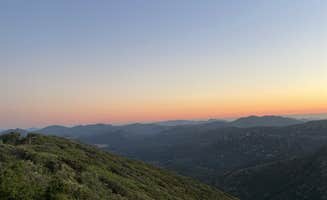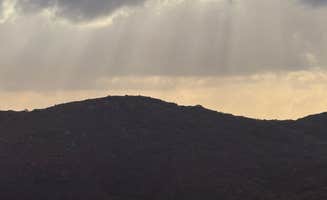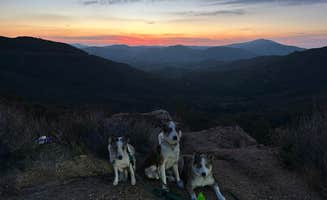Dispersed camping opportunities near Cardiff-by-the-Sea, California require travel to the eastern mountains of San Diego County where elevations range from 3,000 to 5,000 feet. The primitive camping areas feature chaparral vegetation transitioning to oak and pine woodlands at higher elevations. Weather patterns differ significantly from coastal conditions, with winter temperatures dropping below freezing and summer daytime temperatures regularly exceeding 90°F.
What to do
Explore Pacific Crest Trail access points: Kitchen Creek Road serves as a gateway to PCT hiking. According to camper Marco M., the area can be "pretty but busy" with varied traffic including "motorcycles, trucks" making it less suitable for solitary camping experiences.
Visit historical landmarks: Kwaaymii Point offers access to desert viewpoints and historic sites. Located near the Sunrise Highway, this primitive camping area provides strategic positioning for day trips to the desert floor or mountain peaks within Cleveland National Forest.
Practice responsible target shooting: Otay Mountain Camp provides designated areas for shooting activities. Camper Chris A. notes, "This area is a nice area for shooting. It is frequented by shooting enthusiasts from all over the local area." Access requires specific routing: "The entry into this area is from the south by the South Bay Rod and Gun club."
Navigate back-country roads: Grapevine Canyon Road offers challenging terrain for off-road enthusiasts. This primitive route requires high-clearance vehicles and provides access to remote camping locations away from typical tourist traffic.
What campers like
Minimal light pollution for stargazing: Pine Creek Road Camp delivers exceptional night sky viewing. Camper Gabriel S. mentions, "We applied for a permit on Friday and did not get it by Saturday when we departed. Luckily, no rangers patrolled during our stay." The area's distance from urban centers creates optimal stargazing conditions.
Complete solitude: Primitive camping near Cardiff-by-the-Sea allows for genuine isolation. As David notes about Pine Creek Road Camp, "We only spent one night but we never saw another person during our stay." This contrasts sharply with coastal campgrounds where sites typically cluster together.
Recently improved road conditions: Road maintenance varies seasonally. Ruben notes about Pine Creek: "Roads are PAVED, I think that's new because I don't remember that last year when I went!" However, Amanda M. observed at Kitchen Creek Road: "Could be maintained. Went during a very rainy season."
Wildlife viewing opportunities: The transition zone between coastal and desert ecosystems supports diverse animal populations. Campers report encounters with mule deer, coyotes, rabbits, and numerous bird species throughout these primitive camping areas.
What you should know
Navigation challenges: Finding legal camping spots requires research. Regarding Otay Mountain Camp, Caitlin G. advises, "Not all the roads that lead out to the mountain are legal to camp on so be careful where you park. Otay Mountain Rd and Otay Lakes Rd are the only two roads mentioned on the BLM's website."
Variable site quality: Campsite conditions differ significantly within the same area. One Pine Creek camper notes some spots are "fairly large—could easily fit 2 cars and a couple tents—but others seemed to be just large enough to pull off the road and sleep in the car (no tent space)."
Insect preparation essential: Summer months bring increased insect activity. Gabriel S. warns, "There were way more flies than we were expecting. Prepare to get swarmed. Luckily just gnats and no mosquitoes from what we experienced."
Permit requirements: Several dispersed camping areas require advance permits. For Pine Creek, Lillian R. mentions they "stopped at the laguna recreation area visitor center before hand to pick up a free permit."
Tips for camping with families
Limited facilities require self-sufficiency: Most primitive areas have no services. Granite Springs offers minimal facilities, with Chris M. noting it's a "primitive camp site with chemical bathrooms. Has 3 areas to set up tents. First come first serve, but you must check in at the ranger station before you go. $5 per camper."
Visit nearby towns for provisions: Mountain communities provide resupply options. David mentions, "My girlfriend and I stopped in Julian on our way out to get a late lunch and then head to the campsite."
Road safety considerations: Mountain roads present driving hazards. One Pine Creek visitor cautions, "If you're nervous about driving on single lane mountain roads, this is not the place for you! Pine Creek Road is several miles long, with some sections that are on sheer cliff edges with very few turn-off spots to allow for passing."
Allow buffer time for site hunting: Limited site availability requires flexibility. A Pine Creek camper advises counting "only 6 or 7 sites total, separated by up to a mile" making advance planning essential.
Tips from RVers
Size restrictions limit larger vehicles: Most dispersed areas accommodate smaller RVs only. Ruben notes about Pine Creek Road Camp, "If you have a big rig it's a little tight to move around on the roads but definitely nice for sprinters / trucks / suvs or even cars!"
Ground clearance requirements: Unpaved access roads demand appropriate vehicles. One camper mentions for Pine Creek, "I have a stock Rav4 and it was able to drive on it although there are a few spots you need to be careful at so you don't scrape the bottom of your car."
Consider weekday visits: Scissors Crossing PCT Parking and other areas experience increased traffic during peak hiking seasons. Holiday weekends see higher usage, with one camper noting their Pine Creek experience was "a little busy due to the holiday but not too bad."
Download offline maps: Limited connectivity affects navigation. A Pine Creek visitor emphasizes "very spotty service (Verizon), which makes navigation and planning difficult if you don't pre-download trail maps."




